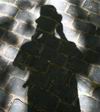I've managed to make a couple of trips over the European summer. The
first was 10 days in Italy and San Marino with my German girlfriend. I
was keen to visit San Marino, one of the world's smallest countries. It
has only 35,000 people, a total area equivalent to a few Melbourne
suburbs, and may as well be part of Italy as it is surrounded by Italy,
and the people speak and eat and look Italian. It is normally a day-trip
destination where the tourists arrive by the busload in the morning,
walk the steep old streets, have some lunch, get their passports stamped
at the tourist centre, and buy some tacky "tax-free" junk, that seemed
to me to be more expensive than regular tax-included prices elsewhere.
Because we arrived on the last bus in for the day, we stayed overnight
and it worked out well. Because people don't normally stay overnight,
the accommodation was cheap. San Marino is mostly a fortified city on a
mountain surrounded by lower land, so every room has a great view. In
the evening we sat on our terrace looking out in one direction to the
Apennines, the mountains which run down Italy's length like a spine, and
in the other direction to the Adriatic Sea. From our terrace we could
watch the locals, young and old, make their evening "passagiata", the
Italian tradition where everybody comes out in the cool late evening
air, strolling up and down the streets chatting, flirting, joking. Soon
after a crossbow tournament took place, all the contestants and judges
dressed in renaissance garb. It was colourful, kitsch, and amateurish,
but what interested me was that this was something they did for
themselves, not for tourists because almost all the tourists had gone in
the afternoon.
Next we went to Florence where I met up with an Australian friend.
Together we walked "la cinque terra", a coastal hiking path connecting 5
villages built on steep hills leading down to the water that allegedly
have maintained traditional lifestyles. Rubbish. It was tourist central.
The walk was good, lots of great scenery, especially as you come around
a bend and see a village in across the next cove. But the villages,
especially the last one we saw seemed to be inhabited only by tourists
save for the shopkeepers. The only tradition I saw was the worldwide
tradition of welcoming the tourist dollar no matter what the cost. We
went for a swim to watch off the sweat and dirt and found ourselves
swimming with fishscales discarded by fisherman, which was less than
pleasant.
For the rest of our Italian trip we used Naples as a base for a few
days. From here we saw Pompeii and Herculaneum which is another ancient
Roman city, like Pompeii buried by Vesuvius but much smaller and better
preserved. The summer heat and smog in Naples was relentless, so the
idea of seeing the ancient water ducts under the city was attractive
especially when the advert said "It's cool underground so you will need
to bring a sweater". We were joined up with a group of German schoolkids
for a guided tour. The tour was in Italian-style English ("Disa waza
builta by...") so the Germans didn't understand much. They got bored and
started acting like bored schoolkids, talking and giggling, tempting me
to test how deep the shafts were by pushing one or two over the edge.
Naples is interesting to see after you have travelled too much. It is
chaotic, crowded, congested, and sort of feels more like a South East
Asian city than a Western European city. In the old part of town people
live in 10 square metre apartments. The streets are lined with hawkers
and vegetable markets that appear wherever the owner feels like. Washing
hangs between buildings over the narrow streets that appear to be
pedestrian-only until motorbikes and small cars come racing through
giving you only a second or two's warning to jump out of the way. There
seems to be little planning with the buildings which are built around
each other and on each other wherever there is room. The city is at the
same time a Catholic stronghold - in one quarter, the "Spanish Quarter",
there are 35 churches in a 2 square kilometre block - and an organised
crime stronghold - the Camorra, the Naples version of the Mafia, has
50,000 members. Even the name of the city is paradoxical - it derives
from Greek for "new city", yet it is anything but new, as it was
established by the ancient Greeks on top of an even older city.
Tuesday, August 17, 2004
Subscribe to:
Post Comments (Atom)

No comments:
Post a Comment